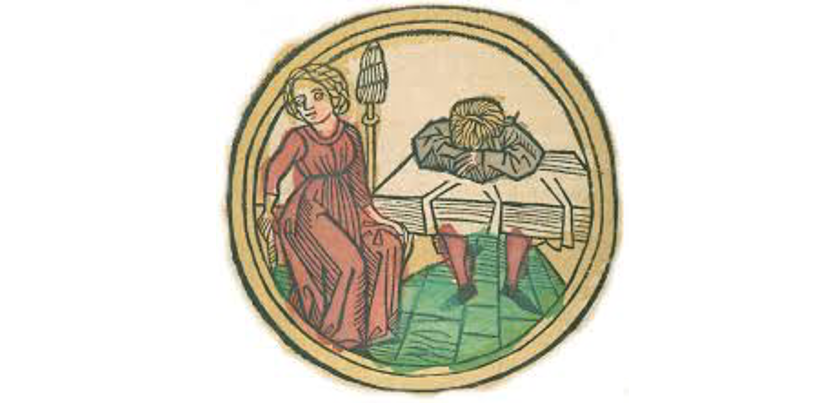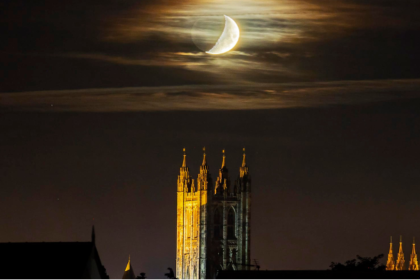In the Middle Ages, there was a very limited understanding of mental illness. One ailment, which we would categorise today as a mental illness, was melancholia. Though it is difficult to divine a definition of melancholia from medieval medical and popular literature, it is clear that along with sadness and despondency, it also included a wide variety of signs of ‘madness’, including convulsions and fits; random, violent outbursts; anxiety; excessive laughter or weeping; and hallucinations and delusions. These symptoms, which were included and collected under the term ‘melancholia’, were either regarded as an illness of the mind, or as a manifestation of supernatural intervention. The social class an afflicted individual belonged to had a huge impact on how their illness was viewed and treated.
~
THEORIES
In the upper echelons of society, the causes of melancholia were based on scientific approaches. Galen’s theory that the body is governed by four humours – black bile, yellow bile, blood, and phlegm – was the dominant medical theory in the Middle Ages. Melancholia, derived literally from the Greek ‘melaina chole’ meaning black bile, was caused by an excess of this particular humour. Alongside this theory, towards the end of the Middle Ages, were astrological causes. Despite the Church’s rulings against astrology, the movements of the heavens were widely considered to have profound effects on human lives, and particularly health. Saturn in particular was widely regarded as a melancholic planet, and could exert a harmful influence over individuals. This view was most prominent in the Late Middle Ages, due in large part to Marsilio Ficino’s ‘De vita libri tres’, published in 1489. The movement of Saturn was believed to affect the balance of black bile, which could cause a person to develop melancholia.
In lower classes of society, there was a lack of scientific or medical understanding, and an inability to access those who did have such training. In this social strata, melancholia was widely believed to be the result of a supernatural causes. Particularly in small communities, melancholia was likely to be seen as caused by either divine inspiration, or the opposite, ranging from normal human sinfulness to demonic possession. For more introverted, hallucinatory forms of melancholia, divine inspiration was sometimes suggested, such as in the case of Ida of Louvain, a holy woman whose withdrawal from society into a private cell in her family home, and reports of visions of Christ’s poor entering her body, led to her becoming regarded being touched by the Holy Spirit. In more manic form of melancholia, with symptoms such as garbled speech and fits, demonic possession was deemed the cause. A demonic cause was the more common attribution, and throughout the Middle Ages melancholia was also known as ‘the Devil’s bath’.
This was because in poorer communities, medical practitioners were mainly monastics or the local parish priest, who would be poorly educated and rely far more on religious superstition rather than scientific tradition. The only education available to both these ‘medical practitioners’ were other, similarly trained priests, creating an echo chamber for the belief about the existence and real-world influence wielded by demonic and holy forces.
~
DIAGNOSIS
Individuals belonging to higher classes had access to and could afford to seek out a physician, or at least a barber surgeon, who had formal medical training, who would examine blood and urine samples for signs of an excess of black bile, as advised in Aristotle’s Prognosticon. In accordance with the prominent urologists Stephen of Athens and Theophilus Protospatharius, colour, sediment, and texture were all considered. Urine which was a ‘strong yellow colour’ or black was believe to be a sign that the body had an excess of black bile, and suggested that the afflicted was suffering from melancholia. They may have also analysed star charts in order to see if any planetary or star movements could be affecting the person, and if so, in what way. In medicine, this discipline would involve a number of practices. Horoscopes of birth and conception were drawn up and interpretations related to symptoms would be made in nativities. By then examining the heavens, revolutions of nativities, taken on birthdays, would show how the star and planetary movements continued to influence the individual. Marsilio Ficino advised physicians to pay particular attention to the possible influences of Saturn and Mercury.
This was very different those at the lower end of the social system. Based on the general manifestation and symptomatology of the melancholia, the priest or monk would assess the patient for signs of demonic possession or holy influence, through ritualistic tests. The priest would expose the person to either the Bible, the Cross, or if the church was rich enough, a holy relic. The person’s reactions were very subjectively judged to be demonic or holy by the priest and parishioners, who would interpret signs of recoil or aggression as signs of a satanic presence.
~
TREATMENT
The formally educated doctors sought out by the wealthy would treat melancholia through purging the excess of black bile from the system. This was usually done through blood-letting with leeches or a fleam. Other methods of purgation were administered, usually herbal remedies, especially hellebore, which would induce diarrhoea and vomiting. There was also some understanding of how diet affected mental wellness. Hildegard of Bingen, as well as many physicians, advised, among other things, hot wine mixed with water, mallow juice, sage, and olive oil to help reduce black bile and treat melancholia. It is unclear how effective these types of treatment were, however we know today that food can have a large effect on mood and mental health.
In communities where the only form of care and authority came from their religious institution, usually smaller, poorer ones, a number of religious interventions were possible. For demonic possession, an exorcism would be performed. Whilst there was wide variance in method, Heinrich Kramer sets out a general form in his Malleus Maleficarum. The exorcism would generally involve a number of ritualistic processes, which began with adjuration. Adjuration was putting the demon under oath, commanding it to speak the truth, in the name of God. This lay the way for the interrogation, which was mainly to discover the name of the demon. This would be done via asking, suggestion, and reading gestures. If this did not work, physical violence and abuse, usually a beating, would be used to in order to extract the information. Violence was justified as ‘retaliation for the tortures’ the demon inflicted spiritually and psychologically on the victim. Sacred objects would then be used to help drive the demon out. These objects would be things such as the consecrated Host, holy candles, Crosses, holy water, and relics. Objects from folklore could be used as well, if blessed by a priest to transform them into religious implements, and include herbs, salt, wine, and stones. Alongside these objects, prayer was used, most commonly Hail Marys, to dispossess the afflicted person of the demon. There is documentary evidence of this form of exorcism successfully curing individuals. Possibly this was down to a ‘placebo-like’ effect; the confidence the rituals and priest inspired that the exorcism would relieve their suffering. There was possibly also an element of Church propaganda involved in the reported success of these exorcisms.
There was another treatment which was sought by people who wanted to avoid the Church’s intervention – a primitive form of shock therapy. There was a large proportion of society who had a very basic understanding of melancholia as an illness of the mind, or, more simply, madness. Without access to a physician, and afraid that a priest would condemn their loved one as possessed by a demon, they would take treatment into their own hands, and attempts would be made to shock the afflicted person out of their infirmity. One of the most common ways of doing this was dunking them in the river, in the hope that the shock of the cold water would snap them out of it. Unfortunately, usually all this did was result in the ‘madman’ catching pneumonia as well.
In the cases when the person was found to be holy, they would be offered guidance by the parish priest, which may include becoming an anchorite/anchoress, or encouraged to join another establishment of holiness. The community would venerate the individual, looking for guidance in exchange for food or other offerings. Ida of Louvain, discussed previously, exemplifies this fate, becoming a Cistercian nun, adding what has been described as ‘éclat’ to her monastery, and eventually receiving beatification. This was something of a double-edged sword; whilst these people would be well-treated, respected, and provided for, their melancholia would go untreated and their suffering seen as something to be treasured as a gift from God. Any alleviation of their symptoms would likely result in them being declared either a fraud, or as suffering from a demonic influence masquerading as divine in order to ensnare people.
With unreliable evidence, it is difficult to assess whether the difference in effectiveness of these different treatments; whether poorer people actually benefitted more from the comfort of religious ritual, or whether access to a physician would have actually made any difference to their condition in any case. However, regardless of the effectiveness of the treatment individuals with melancholia received, the form of that treatment was affected by the class they belonged to, as that directly affected the treatment they could access and afford.
Image source:
A medieval German woodcut from ‘Deutsche Kalendar’ (German Calendar), c.1498, depicts the melancholic disposition





